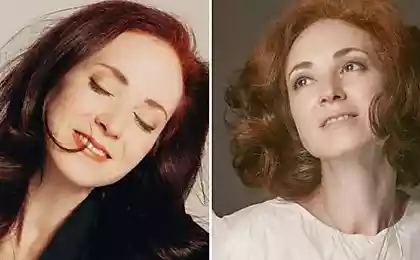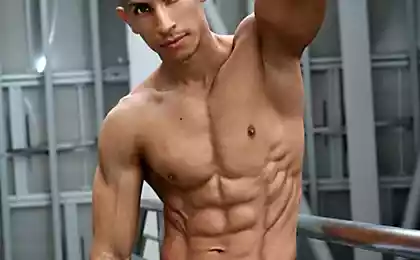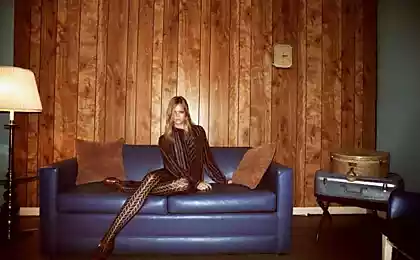1606
Carnivorous?
Sixteen million six hundred thirty six thousand two hundred fourteen
Anna Kingsford, doctor of medical Sciences, Chapter from the book "Scientific basis of vegetarianism, or of killing-free nutrition".
What kind of food prescribed to us by nature? This question is very important. If the person in their organization is adapted to the well-known way of life, without a doubt, this lifestyle is more conducive to the preservation and improvement of its natural qualities.
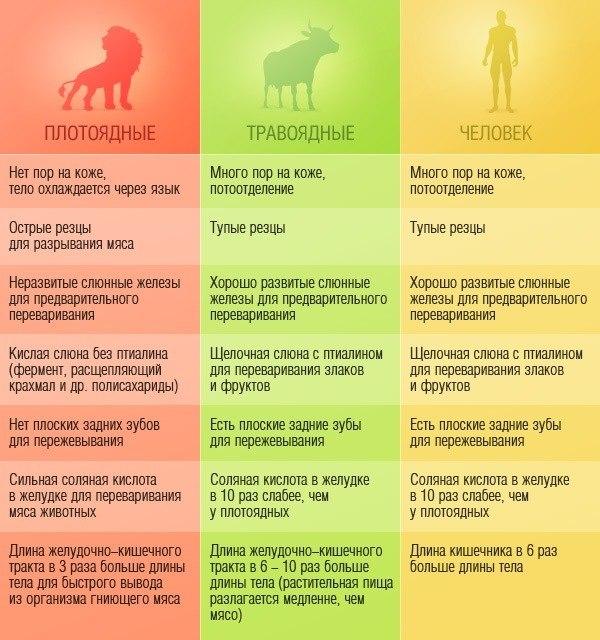
Among the animals we know are carnivorous, omnivorous, herbivorous and frugivorous. To get the answer to our question, it is necessary to handle, to which of the discharges is closest, in its organization, man.
We need not dwell on the theories of Lamarck, Darwin and Haeckel. We can restrict ourselves to the recognized data of comparative anatomy, not aroused any controversy and doubt.
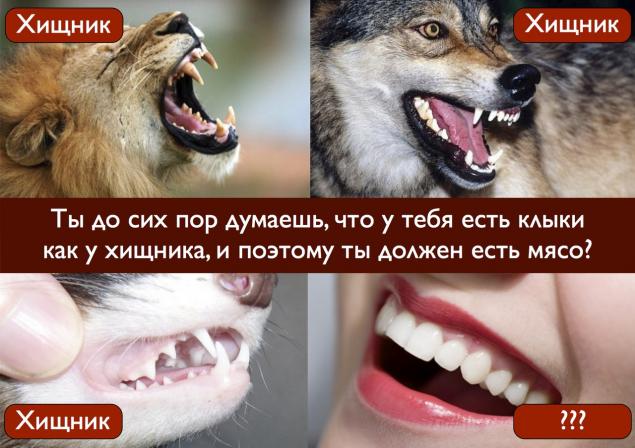
Linnaeus, founder of modern scientific classification, classifies human to primates. This name Linnaeus calls the highest unit in the class of mammals; at its head he places man and the great apes. Of the latter, immediate neighbors are an Old world monkey the orangutan, gorilla and chimpanzee belonging to the family of old world monkeys; orangutan ("wild man") is the representative of the family Simiadae (instead of the term Simiadae, often used as a generic name of the word Pythecus), the gorilla and the chimpanzee belong to the genus Troglodytes.
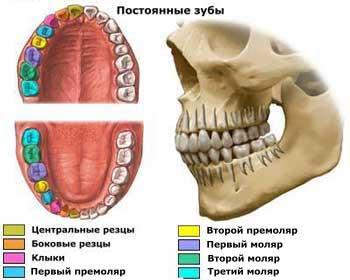
Try to imagine possible in a short essay the most important similarities between man and apes called and the shared features that both employees and monkeys differ from all other mammals.
The similarity of the APE skull with a human catches the eye of even a superficial observation; just as sharply it differs from the skulls of other animals. Without going into details, let's move on to the other side of the case is interesting not so much with the total, how many from a purely scientific point of view.

The most important place in the body belongs, without a doubt, the nervous system; it controls the activity of all organs, making unity and harmony in their administration, monitors the integrity of the tissues and corrects damage; in a word, in the internal economy of the living body is the legislative and administrative authority. Therefore, an animal that has a nervous system and its most important organ — the brain is most similar to human should be considered the closest to human. In General, the more developed the nervous system, especially of its Central organs, and the more complex the device is, the higher is the animal in a number of others.
Of all the creatures in the most razvitoy and complex nervous system is one; of the animals closest to him is the orangutan. Compared to the chimpanzee brain, the brain of an orangutan has a large size is directed from the top down, its more frontal lobe, the occipital smaller, the surface of the parietal lobe deviates less from the horizon, and therefore convex; these signs are consistent and particular kind Simiadae, representative of which is the orangutan.
Monkey, followed by the orangutan, took first place in the animal Kingdom by the number and sharpness of brain furrows; behind them are ruminants and hoofed, even lower — carnivorous; finally, in rodents and edentates the brain grooves exist only in the Bud.
Research lheureux, in the brain of the carnivorous animals there are only six of the cerebral fissures; the different species are carnivorous, they have a uneven idle and proper form, but the direction is always the same: they go from front to back, parallel to one another. Professor Seppi (Sappey) calls them "permanent" or "primary" furrows.
Plus furrow furrow go "advanced" we find the elephant, learnig or prosimians, and in the greatest quantity, apes; these grooves differ from the "primary" its magnitude and its direction are perpendicular to the primary grooves. "Add, says Professor Seppi, to the longitudinal grooves in the surface of the brain of carnivores or one of the inferior mammals, two or three grooves, so that they crossed first in the middle in the transverse direction, you get the picture describing the brain of higher mammals, humans and apes".
The orangutan longitudinal grooves are over a large, bent, branched, and are connected with one another as a person; so pronounced and additional grooves or "furrows improvements", as he calls them Professor, Sappy; their location in the strongest way resembles the human brain. Therefore, there is every reason to think that between the brain of the orangutan and the human brain, there is a difference not by way of a device, but in degree of development, according to Professor Ewarton (Pr. Mivart, Man and Apes, p. 149).
The same idea can be found in the writings of Professor Broca, and the findings of that diligent researcher and expert in anthropology have special weight. According to Brock, the human brain, which Owen puts in a special subclass of "Archencephala" — so a little different from the brain of higher animals, attributed by Owen to the subclass "Gyrencephala" that the difference exists only in secondary characteristics. "These distinctive signs, says Broca, are insignificant in the nature of things; if in the cerebral hemispheres of the apes was not a "posterior horn lateral ventricle" or "small feet sea horse" if, finally, the posterior lobe of the brain does not completely cover the cerebellum, all these differences are so minor that they are almost equivalent to random; the difference is much more significant are observed even between animals belonging to the same unit, and, in any case, such symptoms as the above, not enough for him so, based on them, to make a division into two specific subclass".
A renowned expert on comparative anatomy Professor Huxley sees no reason to emphasize the person's brain in a particular Zoological group and proves that the features that distinguish the human brain ("posterior horn lateral ventricle", "little foot sea horse" and covered the cerebellum and the occipital lobes of the brain)— are present in the brain of the orangutan and other monkeys, and even "developed some of the lower apes are much more than the man" (the Initial Foundation of comparative anatomy. Pens. 1865, p. 116 FF).
Citing briefly the General grounds, pointing with one hand to the similarity of the organization of human and APE, and other — common to both of them a significant difference from other mammals, we can move on to the subject of the anatomical details that are in direct connection with the choice of food. Let's start with the mouth.
Apes have it arranged in the same pattern as that of a human: kiln no bags, Vartanova ducts, i.e., the output channels of both submandibular salivary glands open on either side of the frenulum of the tongue; a language similar to human; the orangutan forked papillae of the tongue are arranged in the form of angle or letter V, as in humans; in chimpanzees, their location is somewhat different — in the form of the letter T.
The shape and number of incisors, canines and molars in monkeys, Old world ("chain") are the same as in humans, only the canine teeth of apes, especially in males, long, and "wisdom teeth" appear at an earlier age than humans.
Monkeys of the New world ("grey") differ from man in that they are deficient in both jaws, on both sides, one large one native tooth, and it takes place extra bicuspid. In humans, the surface of the large molars divided incorrectly branching groove on four or five clearly distinguishable tubercles. The same device and with the same surface location enamel large molars of the orangutan, chimpanzee and gorilla.
Meanwhile, herbivores distribution of enamel completely different: the pachyderms, ruminants (the latter in the upper jaw there are no incisors), rodents with large cheek teeth are built up of layers of dentine, enamel and cement, penetrating through the entire thickness of the tooth, so that the cross section of the tooth is visible a circle of dentine, clad with one layer of enamel, as happens in humans and monkeys, and a significant number of wavy curved folds; the dentin, with less strength, faster is destroyed and the tooth becomes rough, issubmenu surface, adapted to the mastication of vegetable fiber, which is always in the diet of these animals.
On the other hand, the teeth of the carnivores, according to Cuesa, are not teeth in the proper sense of the word: it is rather vozduhonosnye instruments designated for tearing apart their food — meat. They have incisors six in each jaw, instead of four; they are small, pointed and do not agree with each other; large molars there is only one on each side of the jaw and a crown reminiscent of the saw.
Quite unique is the shape of these animals last small indigenous or "carnivorous tooth", especially well-developed in tiger: the crown consists of three acute tubercles is significant, but not the same size, sitting one after the other and United the outstanding edge of the tooth; the anterior tubercle is another plus point. Nothing like this occurs in humans and the nearest animals.
Next to the purely predatory animals should be put omnivorous: Alpine and North American bear (ursus arctos), wild boar and pig (sus scrofa, sus tiberianus and sus ibericus). The bear surface of the large molars smooth, but six incisors, as in true carnivorous, but they are not so sharp and form peculiar to the cutters, is expressed not so sharply. The fangs are very long and curved; between the canine and the nearest small indigenous tooth commonly there is a noticeable gap.
Thus, the device of the teeth, omnivores are closer to carnivores than to herbivores and frugivorous and humans have almost nothing in common, except the same surface location of the enamel on the molars. The incisors of the wild boar and domestic pigs are long and protrude, in a continuation of the jaw bone. Canines, especially in the upper jaw, are unique: they are outward and intersect with the bottom. In pigs and wild boar, there is a gap between the canines and small molars.
Now let me turn to the device of the zygomatic arch and the temporal region: it is important for us in the sense that his nature is possible to determine what food is peculiar to this animal.
In humans and apes the zygomatic arch is relatively thin and somewhat bent upward so that their lower surface is concave; temporal and masticatory muscles are developed rather poorly.
The ruminants of the temporal muscle also is not great, but masticatory muscle reaches a large size: it starts above the zygomatic arch, and occupies the entire lateral surface of the upper jaw; the lower jaw they have designed so that it can produce a kind of movement to the right and to the left: its small articular head and articular slide in the holes from side to side. A different kind of articular head in the jaws of rodents: it is thickened in front to rear, and the articular fossa a simple depression.
In humans, the lower jaw can also move in both directions, forward and backward, which is necessary for grinding solid food. (See. Girl. Guide to human anatomy. Pens. 1879, p. 193).
Just farther from man are in this respect carnivores. They have a zygomatic arch is very thick; its strength increases, a strong bending down so that their lower surface is convex — absolutely back to the fact that we meet a person, and convexity the sharper, the more rapacity in the manners of the animal.
Due to its size and peculiar form of the zygomatic bone in the skull of prey animals strongly protrude and are extremely durable support for muscles, acting in tearing prey apart. Of these muscles are strongly developed masticatory and temporal; the latter fills the space between the temporal bone and its zygomatic process, and in height reaches the top of the skull. The inner and outer pterygoid muscles, on the contrary, developed very poorly; predatory animals lower jaw has lateral movement: it prevents too deep articular fossa; that the lower jaw can only rotate up and down. Omnivorous in this respect little different from carnivores. In General, the device of the motor mechanism of the lower jaw, a close resemblance is observed only in monkeys and in the most extreme — birth Simiadae and Troglodytes.
The conclusions lead us to compare animals on the structure of the brain, the device of the mouth and teeth, according to the method of attachment of the lower jaw and its muscles, supplemented by anatomical data on the internal digestive organs.
The human stomach is simple, i.e. consists of only one room for cooking, as all primates. Through the courtesy of Professor Brock, I had the opportunity to inspect the drawings and preparations, collected in his anthropological study; they prove with startling evidence of unity in the organization of the digestive organs of humans and the higher apes; on first glance is not noticeable any difference. Only a careful comparison, you can see that the human stomach is somewhat smaller monkey. As for the intestinal canal of great apes, it is not the slightest deviation from the human; the cecum has no mesentery, and is held in place in the right iliac region directly by the peritoneum; the vermiform Appendix exists in all animals of the same length as that of a human. For Gastly: "only two mammals have it: the orangutan and the wombat". Str. 447.
The liver is the orangutan (and also of the Gibbon) is just as easy as in humans; in chimpanzees it is even easier: the rear or Spigelau the blade is smaller and the groove for the passage of the inferior Vena cava transformed into a simple impression. We should notice that the structure of the liver and in some other respects apes are significantly different from the other animals of the order primates and, on the contrary, do not differ significantly from person to person. The gall bladder exists in all primates, other mammals it is absent in the Cetacea, sloths, rhinos, elephants, camels, horses and tapirs.
Position of the peritoneum and both seals the orangutan is almost identical with the device of the abdominal cavity in humans, and we should remember that the known, very complicated arrangement of folds of the peritoneum and their mutual correlations are a consequence of the change in location of the abdominal organs that occur in a certain sequence in the development of the embryo; therefore, this aspect of the case is of great importance.
Between chimpanzee and human observed in this respect some difference: seal the chimpanzee is attached to the upper part of the ascending colon on the very limited extent; but the ascending colon and the upper part of the caecum in this animal, as well as gorillas and orangutans, are attached through the peritoneum to one side of the spine in the same way as humans. (Broca. "L'ordre des Primates". Bulletins de la Societe d Antropologie, vol. IV.)
The stomach of the carnivorous quadrupeds differs from the human stomach as a relative value, and form. In him there is no separation into parts (portiones et cardiaca pylorica) and it works every carnivore in a simple bag, elongated slightly in the transverse direction from right to left. Intestinal canal longer than the body of the animal from 3 to 6 times, while in monkeys and man from 7-10 times. The liver of a carnivore is much more complicated than that; it consists of six separate parts or blades. The cecum is not commonly found, and in cases where it is observed, it is found in embryonic form.
On the other hand, the stomach of herbivorous animals, especially ruminants, is very complex; however, where it is easier, as the horse, the lack of complexity is covered by the increased development of blind and colon. From ruminants has four separate areas for food: "scar", "sleeve", "owner" or sheet stomach and "rennet"; the alimentary canal is longer than body 12 to 27 times.
Not to ignore are omnivores, we take the example of pig. In this animal the bottom of the stomach (fundus ventriculi), in the sky, in the form of a bag, and from him to lead the opening stretch two parallel folds — not as humans.
Dr. beaumont (Beaumont) his famous experiments on Alexis St. Martin (the canadian was a fistula in the stomach, through which it was possible to directly observe digestive processes) have shown that peristaltic contractions of the stomach the food goes through its cycle: the part that in a certain moment was at the greater curvature of the stomach, moves right to the pin hole, and the other part, the former have a lesser curvature, moving this time to the left, to the inlet of the stomach. Thus, the human stomach produces, first, the peristaltic movement, coming from the greater curvature and, second, antiperistaltics movement from the lesser curvature.
Currently, it is possible to consider proven that herbivores both these movements exist; no doubt the same is true in mammals of the Zoological order of the detachment to which the person belongs. On the contrary, carnivorous food just moves from right to left and back. (Beglar and Schultz) Over omnivores of similar observations, apparently, was not done; judging from their General resemblance to the carnivorous, it is difficult to expect a difference in this regard.
Regarding the chemical composition of the digestive juices can make the following observations.
First, rarely have the chance to explore the digestive fluids in humans in their physiological state, i.e., in the same form as they exist in a healthy body. The same thing, in essence, also applies to animals, as violent operations, like artificial fistula, etc., the conditions for obtaining the digestive fluids are so complicated that the results of the analysis are not convincing. It is quite probable that in many cases, while the chemist will be able to obtain these fluids from separate component parts, their composition will have time to change.
Second, the composition of the digestive juices is changed in accordance with the degree of food, so you can expect a noticeable difference in this respect between the two people, one of whom routinely eats meat and the other does not drink. In any case, it is known that the departure of the body, including the allocation, to a large extent and relatively quickly adapt themselves to food and lifestyle.
For example, a carnivorous animal during eating stands out saliva, relatively speaking, much smaller than in herbivores; the same is seen in people who eat meat food. But as it turns out, if the same persons are switching to plant-based diet, the activity of the salivary glands, they have significantly intensified: it adapts to the new requirements. It follows logically that the same adaptation occurs in the chemical composition of digestive juices. To prove this conclusion can, of course, only comparative analyses, but, unfortunately, does not exist.
However, despite the above considerations, we can point to some facts, it is established by science. According to Bernard, Tape, etc. the human saliva, even in everyday meat eating, in chemical terms is more similarities with the saliva of herbivores than carnivores. Human saliva has the ability to convert starch into sugar (this action produces a special enzyme ptyalin, which is in the saliva; ptyalin is a great similarity with the diastase fermentation of malt substance), whereas the saliva of a carnivore is completely devoid of this ability: their sole purpose is to moisten the food and facilitate swallowing. Similarly, studies of Frerichs and Gorup-Bezanis, human bile is of the same composition in the bile of herbivores. (Etudes sur des Supplicies.)
In conclusion, this essay think not superfluous to mention another sharp difference between carnivores, on the one hand, and on the other hand herbivores and monkeys. At last the sweat glands developed much stronger both quantitatively and qualitatively. This is understandable: their food is much richer teploproduktsii elements, and, naturally, causes increased separation of the sweat. Man in this respect also converges with herbivorous and frugivorous.
We for no reason experienced the patience of the reader rather tedious with the details of comparative anatomy and physiology. You need to fight about opinions, especially when they are shared not only the common audience but also people with scientific education. How long have spoke with complete conviction about the fangs or the "dog teeth" and simple human stomach, how about the obvious evidence that he is nature itself had intended to eat meat! If this is the proof, as seen by the reader, it further should refer to the monkeys: they have "canine teeth" are much longer and stronger than a human, so that zoologists need to hurry to fix the existing classification of animals and to classify carnivorous and omnivorous of all animals, which is now placed in the order primates.
However, with the exception of man, in primates there is no animal that in a natural state harbored would be organic aversion to meat (Brock, Mozart, Owen, etc.)! To tame the apes is not quite applicable: in the famous essay, Bram, for example, are the stories that tame monkeys willingly eat boiled meat, drink vodka and smoke tobacco, therefore, are also able to acquire artificial needs as people.
Pouchet (Pluralite de la race humaine, p. 39) observed that the device of the teeth, and digestive organs present "as evidence of his primitive prodiagnose..." Opinion is shared by Professor Owen in his words, humanoid and everything ketveriuke eat only fruits, grains and other nutritional or juicy pieces of the vegetable Kingdom, so that, taking into account the very close anatomical structure of these animals with man, the latter also has to be considered frugivorous.
The same opinion was expressed by Cuvier (Regne animal), Linnaeus, Professor Lawrence (Lectures on Physiology), Charles bell (Diseases of the Teeth), Gassendi, Flourens, and many other famous scientists. Says Flourens, "a Man can not be assigned neither carnivorous nor herbivorous. He has no four stomachs or intestines such or such teeth, as in ruminants. Considering these organs in man, we must come to the conclusion that by nature and origin frugivorous, he, like the APE."
We can argue that, if the person is in their structure and natural instincts are to eat fruits and seeds, he should not eat herbs and roots, it is rather the food of herbivores, and we are able to prove that their organization is very different from the organization of man. You can finally say that it is wasted effort to search for what category of animal is closest to the people, if he, in contrast to all animals, is able to replace nature with art and, by means of fire, condiments and side dishes are not only without disgust, but even with a good appetite and is free to digest food tiger, wolf and hyena.
These objections are not deprived of the visible base. Answering them, I just consider it my duty to Express directly that, indeed, the most natural and best food for humans is nesvarenie fruits and seeds of plants, not the plants themselves as a whole, with leaves and roots. But, thanks to the confluence of many natural and artificial conditions, this is the best power source became unavailable for a large part of the population of the globe, and the increasing number of consumer items by kitchen aid was a matter of necessity and prudence. The use of fire natural and legitimate for plant works — such as herbs, roots, hard fruits that are raw are not appropriate to the anatomical and physiological characteristics of the human body.
Real fruit, which by nature belongs to man, not refuse to eat such cooked food even in those countries where a lot of fruit. As you know, in the Paris Jardin des Plantes, the menageries and other daily food of monkeys consists of apples, salad, boiled potatoes and bread; hence, it includes: seeds of cereals, root plants, the grass, and fruits. This food is not only not repugnant to these lovers of the fruit, but, on the contrary, stimulates appetite one of its kind and smell and even raw attractive to their sight, smell and imagination. But for a man the choice between the extremes of naturalness and artificiality between the garden and carnage, incomparably more diverse than any creature of the humanoid breed, and more importantly, this choice is associated with much deeper, not Zoological considerations.
The life of the farmer and gardener are quite compatible with the requirements of personal and public hygiene, the benefits of private and public sector, with the ideals of morality, finally, with high aspirations to beauty, to goodness, to true philosophy, aspirations, animating the best part of the enlightened humanity. On the contrary, as the reader will see from the subsequent presentation, all of these requirements, all these better feeling violated and insulted with abuse poverenny art, which became in the hands of man a means to relegate himself to the level of a predatory animal.
But, perhaps, the transformation of man from a frugivorous creature in carnivores and omnivores have given him any benefits, has improved its natural qualities? After all, in addition to misconceptions about the organization is quite common and another as a wrong opinion: I think that meat food is the best source of physical strength; to be strong, strong, full of muscular energy, you need to eat more meat. This view, like the one we just did, finds supporters not only in society but even among medical doctors and professors of medicine; these men of science often adhere to walking opinions not based on scientific studies, but simply by routine.
We daily meet on the streets, in the fields the most obvious refutation of this opinion. The most strong, hardy and healthy working animals is not only used Masnou food, but do not tolerate it. In this respect, it's impossible to compare their plump meat owners. All work on the globe are produced in herbivores: horses, mules, oxen, camels, elephants; they plow the fields, they build cities, they serve in time of war, and give us the opportunity to travel; they created our civilization, trade and national welfare.
No carnivorous animal can't argue in effect with herbivorous Rhino: he almost without effort breaks trees and branches disperses like blades of grass. No predator has the strength and endurance of the horse; it carries enormous weight morning to night almost without rest; no wonder HP has become proverbial. According to Duchally, gorilla — and she eats only flat and nuts — in his eyes, apparently without any effort, broke the gun in half, fell from the hands of one of the hunters; the most famous naturalist Dr. Duncan argues that the gorilla in his native woods is a more than rival of the African lion.
Buffalo, Buffalo, Hippo, bull, Zebra, deer's samples or enormous growth and excessive force or striking of the proportionality of the members; and they borrow from nature and its vital elements are not through the meat and blood of their own kind of animals and take them from the original manpower from wild plants, fruits and steppe grasses.
In carnivorous animals, except for bloodthirsty, striking another terrible quality, ferocity. If we look for strength, stamina, courage and intelligence in the work, we will have to turn to the animals that from the beginning of history of mankind share with him his fate, successes and conquests.
Anna Kingsford, doctor of medical Sciences, Chapter from the book "Scientific basis of vegetarianism, or of killing-free nutrition".
What kind of food prescribed to us by nature? This question is very important. If the person in their organization is adapted to the well-known way of life, without a doubt, this lifestyle is more conducive to the preservation and improvement of its natural qualities.

Among the animals we know are carnivorous, omnivorous, herbivorous and frugivorous. To get the answer to our question, it is necessary to handle, to which of the discharges is closest, in its organization, man.
We need not dwell on the theories of Lamarck, Darwin and Haeckel. We can restrict ourselves to the recognized data of comparative anatomy, not aroused any controversy and doubt.

Linnaeus, founder of modern scientific classification, classifies human to primates. This name Linnaeus calls the highest unit in the class of mammals; at its head he places man and the great apes. Of the latter, immediate neighbors are an Old world monkey the orangutan, gorilla and chimpanzee belonging to the family of old world monkeys; orangutan ("wild man") is the representative of the family Simiadae (instead of the term Simiadae, often used as a generic name of the word Pythecus), the gorilla and the chimpanzee belong to the genus Troglodytes.

Try to imagine possible in a short essay the most important similarities between man and apes called and the shared features that both employees and monkeys differ from all other mammals.
The similarity of the APE skull with a human catches the eye of even a superficial observation; just as sharply it differs from the skulls of other animals. Without going into details, let's move on to the other side of the case is interesting not so much with the total, how many from a purely scientific point of view.

The most important place in the body belongs, without a doubt, the nervous system; it controls the activity of all organs, making unity and harmony in their administration, monitors the integrity of the tissues and corrects damage; in a word, in the internal economy of the living body is the legislative and administrative authority. Therefore, an animal that has a nervous system and its most important organ — the brain is most similar to human should be considered the closest to human. In General, the more developed the nervous system, especially of its Central organs, and the more complex the device is, the higher is the animal in a number of others.
Of all the creatures in the most razvitoy and complex nervous system is one; of the animals closest to him is the orangutan. Compared to the chimpanzee brain, the brain of an orangutan has a large size is directed from the top down, its more frontal lobe, the occipital smaller, the surface of the parietal lobe deviates less from the horizon, and therefore convex; these signs are consistent and particular kind Simiadae, representative of which is the orangutan.
Monkey, followed by the orangutan, took first place in the animal Kingdom by the number and sharpness of brain furrows; behind them are ruminants and hoofed, even lower — carnivorous; finally, in rodents and edentates the brain grooves exist only in the Bud.
Research lheureux, in the brain of the carnivorous animals there are only six of the cerebral fissures; the different species are carnivorous, they have a uneven idle and proper form, but the direction is always the same: they go from front to back, parallel to one another. Professor Seppi (Sappey) calls them "permanent" or "primary" furrows.
Plus furrow furrow go "advanced" we find the elephant, learnig or prosimians, and in the greatest quantity, apes; these grooves differ from the "primary" its magnitude and its direction are perpendicular to the primary grooves. "Add, says Professor Seppi, to the longitudinal grooves in the surface of the brain of carnivores or one of the inferior mammals, two or three grooves, so that they crossed first in the middle in the transverse direction, you get the picture describing the brain of higher mammals, humans and apes".
The orangutan longitudinal grooves are over a large, bent, branched, and are connected with one another as a person; so pronounced and additional grooves or "furrows improvements", as he calls them Professor, Sappy; their location in the strongest way resembles the human brain. Therefore, there is every reason to think that between the brain of the orangutan and the human brain, there is a difference not by way of a device, but in degree of development, according to Professor Ewarton (Pr. Mivart, Man and Apes, p. 149).
The same idea can be found in the writings of Professor Broca, and the findings of that diligent researcher and expert in anthropology have special weight. According to Brock, the human brain, which Owen puts in a special subclass of "Archencephala" — so a little different from the brain of higher animals, attributed by Owen to the subclass "Gyrencephala" that the difference exists only in secondary characteristics. "These distinctive signs, says Broca, are insignificant in the nature of things; if in the cerebral hemispheres of the apes was not a "posterior horn lateral ventricle" or "small feet sea horse" if, finally, the posterior lobe of the brain does not completely cover the cerebellum, all these differences are so minor that they are almost equivalent to random; the difference is much more significant are observed even between animals belonging to the same unit, and, in any case, such symptoms as the above, not enough for him so, based on them, to make a division into two specific subclass".
A renowned expert on comparative anatomy Professor Huxley sees no reason to emphasize the person's brain in a particular Zoological group and proves that the features that distinguish the human brain ("posterior horn lateral ventricle", "little foot sea horse" and covered the cerebellum and the occipital lobes of the brain)— are present in the brain of the orangutan and other monkeys, and even "developed some of the lower apes are much more than the man" (the Initial Foundation of comparative anatomy. Pens. 1865, p. 116 FF).
Citing briefly the General grounds, pointing with one hand to the similarity of the organization of human and APE, and other — common to both of them a significant difference from other mammals, we can move on to the subject of the anatomical details that are in direct connection with the choice of food. Let's start with the mouth.
Apes have it arranged in the same pattern as that of a human: kiln no bags, Vartanova ducts, i.e., the output channels of both submandibular salivary glands open on either side of the frenulum of the tongue; a language similar to human; the orangutan forked papillae of the tongue are arranged in the form of angle or letter V, as in humans; in chimpanzees, their location is somewhat different — in the form of the letter T.
The shape and number of incisors, canines and molars in monkeys, Old world ("chain") are the same as in humans, only the canine teeth of apes, especially in males, long, and "wisdom teeth" appear at an earlier age than humans.
Monkeys of the New world ("grey") differ from man in that they are deficient in both jaws, on both sides, one large one native tooth, and it takes place extra bicuspid. In humans, the surface of the large molars divided incorrectly branching groove on four or five clearly distinguishable tubercles. The same device and with the same surface location enamel large molars of the orangutan, chimpanzee and gorilla.
Meanwhile, herbivores distribution of enamel completely different: the pachyderms, ruminants (the latter in the upper jaw there are no incisors), rodents with large cheek teeth are built up of layers of dentine, enamel and cement, penetrating through the entire thickness of the tooth, so that the cross section of the tooth is visible a circle of dentine, clad with one layer of enamel, as happens in humans and monkeys, and a significant number of wavy curved folds; the dentin, with less strength, faster is destroyed and the tooth becomes rough, issubmenu surface, adapted to the mastication of vegetable fiber, which is always in the diet of these animals.
On the other hand, the teeth of the carnivores, according to Cuesa, are not teeth in the proper sense of the word: it is rather vozduhonosnye instruments designated for tearing apart their food — meat. They have incisors six in each jaw, instead of four; they are small, pointed and do not agree with each other; large molars there is only one on each side of the jaw and a crown reminiscent of the saw.
Quite unique is the shape of these animals last small indigenous or "carnivorous tooth", especially well-developed in tiger: the crown consists of three acute tubercles is significant, but not the same size, sitting one after the other and United the outstanding edge of the tooth; the anterior tubercle is another plus point. Nothing like this occurs in humans and the nearest animals.
Next to the purely predatory animals should be put omnivorous: Alpine and North American bear (ursus arctos), wild boar and pig (sus scrofa, sus tiberianus and sus ibericus). The bear surface of the large molars smooth, but six incisors, as in true carnivorous, but they are not so sharp and form peculiar to the cutters, is expressed not so sharply. The fangs are very long and curved; between the canine and the nearest small indigenous tooth commonly there is a noticeable gap.
Thus, the device of the teeth, omnivores are closer to carnivores than to herbivores and frugivorous and humans have almost nothing in common, except the same surface location of the enamel on the molars. The incisors of the wild boar and domestic pigs are long and protrude, in a continuation of the jaw bone. Canines, especially in the upper jaw, are unique: they are outward and intersect with the bottom. In pigs and wild boar, there is a gap between the canines and small molars.
Now let me turn to the device of the zygomatic arch and the temporal region: it is important for us in the sense that his nature is possible to determine what food is peculiar to this animal.
In humans and apes the zygomatic arch is relatively thin and somewhat bent upward so that their lower surface is concave; temporal and masticatory muscles are developed rather poorly.
The ruminants of the temporal muscle also is not great, but masticatory muscle reaches a large size: it starts above the zygomatic arch, and occupies the entire lateral surface of the upper jaw; the lower jaw they have designed so that it can produce a kind of movement to the right and to the left: its small articular head and articular slide in the holes from side to side. A different kind of articular head in the jaws of rodents: it is thickened in front to rear, and the articular fossa a simple depression.
In humans, the lower jaw can also move in both directions, forward and backward, which is necessary for grinding solid food. (See. Girl. Guide to human anatomy. Pens. 1879, p. 193).
Just farther from man are in this respect carnivores. They have a zygomatic arch is very thick; its strength increases, a strong bending down so that their lower surface is convex — absolutely back to the fact that we meet a person, and convexity the sharper, the more rapacity in the manners of the animal.
Due to its size and peculiar form of the zygomatic bone in the skull of prey animals strongly protrude and are extremely durable support for muscles, acting in tearing prey apart. Of these muscles are strongly developed masticatory and temporal; the latter fills the space between the temporal bone and its zygomatic process, and in height reaches the top of the skull. The inner and outer pterygoid muscles, on the contrary, developed very poorly; predatory animals lower jaw has lateral movement: it prevents too deep articular fossa; that the lower jaw can only rotate up and down. Omnivorous in this respect little different from carnivores. In General, the device of the motor mechanism of the lower jaw, a close resemblance is observed only in monkeys and in the most extreme — birth Simiadae and Troglodytes.
The conclusions lead us to compare animals on the structure of the brain, the device of the mouth and teeth, according to the method of attachment of the lower jaw and its muscles, supplemented by anatomical data on the internal digestive organs.
The human stomach is simple, i.e. consists of only one room for cooking, as all primates. Through the courtesy of Professor Brock, I had the opportunity to inspect the drawings and preparations, collected in his anthropological study; they prove with startling evidence of unity in the organization of the digestive organs of humans and the higher apes; on first glance is not noticeable any difference. Only a careful comparison, you can see that the human stomach is somewhat smaller monkey. As for the intestinal canal of great apes, it is not the slightest deviation from the human; the cecum has no mesentery, and is held in place in the right iliac region directly by the peritoneum; the vermiform Appendix exists in all animals of the same length as that of a human. For Gastly: "only two mammals have it: the orangutan and the wombat". Str. 447.
The liver is the orangutan (and also of the Gibbon) is just as easy as in humans; in chimpanzees it is even easier: the rear or Spigelau the blade is smaller and the groove for the passage of the inferior Vena cava transformed into a simple impression. We should notice that the structure of the liver and in some other respects apes are significantly different from the other animals of the order primates and, on the contrary, do not differ significantly from person to person. The gall bladder exists in all primates, other mammals it is absent in the Cetacea, sloths, rhinos, elephants, camels, horses and tapirs.
Position of the peritoneum and both seals the orangutan is almost identical with the device of the abdominal cavity in humans, and we should remember that the known, very complicated arrangement of folds of the peritoneum and their mutual correlations are a consequence of the change in location of the abdominal organs that occur in a certain sequence in the development of the embryo; therefore, this aspect of the case is of great importance.
Between chimpanzee and human observed in this respect some difference: seal the chimpanzee is attached to the upper part of the ascending colon on the very limited extent; but the ascending colon and the upper part of the caecum in this animal, as well as gorillas and orangutans, are attached through the peritoneum to one side of the spine in the same way as humans. (Broca. "L'ordre des Primates". Bulletins de la Societe d Antropologie, vol. IV.)
The stomach of the carnivorous quadrupeds differs from the human stomach as a relative value, and form. In him there is no separation into parts (portiones et cardiaca pylorica) and it works every carnivore in a simple bag, elongated slightly in the transverse direction from right to left. Intestinal canal longer than the body of the animal from 3 to 6 times, while in monkeys and man from 7-10 times. The liver of a carnivore is much more complicated than that; it consists of six separate parts or blades. The cecum is not commonly found, and in cases where it is observed, it is found in embryonic form.
On the other hand, the stomach of herbivorous animals, especially ruminants, is very complex; however, where it is easier, as the horse, the lack of complexity is covered by the increased development of blind and colon. From ruminants has four separate areas for food: "scar", "sleeve", "owner" or sheet stomach and "rennet"; the alimentary canal is longer than body 12 to 27 times.
Not to ignore are omnivores, we take the example of pig. In this animal the bottom of the stomach (fundus ventriculi), in the sky, in the form of a bag, and from him to lead the opening stretch two parallel folds — not as humans.
Dr. beaumont (Beaumont) his famous experiments on Alexis St. Martin (the canadian was a fistula in the stomach, through which it was possible to directly observe digestive processes) have shown that peristaltic contractions of the stomach the food goes through its cycle: the part that in a certain moment was at the greater curvature of the stomach, moves right to the pin hole, and the other part, the former have a lesser curvature, moving this time to the left, to the inlet of the stomach. Thus, the human stomach produces, first, the peristaltic movement, coming from the greater curvature and, second, antiperistaltics movement from the lesser curvature.
Currently, it is possible to consider proven that herbivores both these movements exist; no doubt the same is true in mammals of the Zoological order of the detachment to which the person belongs. On the contrary, carnivorous food just moves from right to left and back. (Beglar and Schultz) Over omnivores of similar observations, apparently, was not done; judging from their General resemblance to the carnivorous, it is difficult to expect a difference in this regard.
Regarding the chemical composition of the digestive juices can make the following observations.
First, rarely have the chance to explore the digestive fluids in humans in their physiological state, i.e., in the same form as they exist in a healthy body. The same thing, in essence, also applies to animals, as violent operations, like artificial fistula, etc., the conditions for obtaining the digestive fluids are so complicated that the results of the analysis are not convincing. It is quite probable that in many cases, while the chemist will be able to obtain these fluids from separate component parts, their composition will have time to change.
Second, the composition of the digestive juices is changed in accordance with the degree of food, so you can expect a noticeable difference in this respect between the two people, one of whom routinely eats meat and the other does not drink. In any case, it is known that the departure of the body, including the allocation, to a large extent and relatively quickly adapt themselves to food and lifestyle.
For example, a carnivorous animal during eating stands out saliva, relatively speaking, much smaller than in herbivores; the same is seen in people who eat meat food. But as it turns out, if the same persons are switching to plant-based diet, the activity of the salivary glands, they have significantly intensified: it adapts to the new requirements. It follows logically that the same adaptation occurs in the chemical composition of digestive juices. To prove this conclusion can, of course, only comparative analyses, but, unfortunately, does not exist.
However, despite the above considerations, we can point to some facts, it is established by science. According to Bernard, Tape, etc. the human saliva, even in everyday meat eating, in chemical terms is more similarities with the saliva of herbivores than carnivores. Human saliva has the ability to convert starch into sugar (this action produces a special enzyme ptyalin, which is in the saliva; ptyalin is a great similarity with the diastase fermentation of malt substance), whereas the saliva of a carnivore is completely devoid of this ability: their sole purpose is to moisten the food and facilitate swallowing. Similarly, studies of Frerichs and Gorup-Bezanis, human bile is of the same composition in the bile of herbivores. (Etudes sur des Supplicies.)
In conclusion, this essay think not superfluous to mention another sharp difference between carnivores, on the one hand, and on the other hand herbivores and monkeys. At last the sweat glands developed much stronger both quantitatively and qualitatively. This is understandable: their food is much richer teploproduktsii elements, and, naturally, causes increased separation of the sweat. Man in this respect also converges with herbivorous and frugivorous.
We for no reason experienced the patience of the reader rather tedious with the details of comparative anatomy and physiology. You need to fight about opinions, especially when they are shared not only the common audience but also people with scientific education. How long have spoke with complete conviction about the fangs or the "dog teeth" and simple human stomach, how about the obvious evidence that he is nature itself had intended to eat meat! If this is the proof, as seen by the reader, it further should refer to the monkeys: they have "canine teeth" are much longer and stronger than a human, so that zoologists need to hurry to fix the existing classification of animals and to classify carnivorous and omnivorous of all animals, which is now placed in the order primates.
However, with the exception of man, in primates there is no animal that in a natural state harbored would be organic aversion to meat (Brock, Mozart, Owen, etc.)! To tame the apes is not quite applicable: in the famous essay, Bram, for example, are the stories that tame monkeys willingly eat boiled meat, drink vodka and smoke tobacco, therefore, are also able to acquire artificial needs as people.
Pouchet (Pluralite de la race humaine, p. 39) observed that the device of the teeth, and digestive organs present "as evidence of his primitive prodiagnose..." Opinion is shared by Professor Owen in his words, humanoid and everything ketveriuke eat only fruits, grains and other nutritional or juicy pieces of the vegetable Kingdom, so that, taking into account the very close anatomical structure of these animals with man, the latter also has to be considered frugivorous.
The same opinion was expressed by Cuvier (Regne animal), Linnaeus, Professor Lawrence (Lectures on Physiology), Charles bell (Diseases of the Teeth), Gassendi, Flourens, and many other famous scientists. Says Flourens, "a Man can not be assigned neither carnivorous nor herbivorous. He has no four stomachs or intestines such or such teeth, as in ruminants. Considering these organs in man, we must come to the conclusion that by nature and origin frugivorous, he, like the APE."
We can argue that, if the person is in their structure and natural instincts are to eat fruits and seeds, he should not eat herbs and roots, it is rather the food of herbivores, and we are able to prove that their organization is very different from the organization of man. You can finally say that it is wasted effort to search for what category of animal is closest to the people, if he, in contrast to all animals, is able to replace nature with art and, by means of fire, condiments and side dishes are not only without disgust, but even with a good appetite and is free to digest food tiger, wolf and hyena.
These objections are not deprived of the visible base. Answering them, I just consider it my duty to Express directly that, indeed, the most natural and best food for humans is nesvarenie fruits and seeds of plants, not the plants themselves as a whole, with leaves and roots. But, thanks to the confluence of many natural and artificial conditions, this is the best power source became unavailable for a large part of the population of the globe, and the increasing number of consumer items by kitchen aid was a matter of necessity and prudence. The use of fire natural and legitimate for plant works — such as herbs, roots, hard fruits that are raw are not appropriate to the anatomical and physiological characteristics of the human body.
Real fruit, which by nature belongs to man, not refuse to eat such cooked food even in those countries where a lot of fruit. As you know, in the Paris Jardin des Plantes, the menageries and other daily food of monkeys consists of apples, salad, boiled potatoes and bread; hence, it includes: seeds of cereals, root plants, the grass, and fruits. This food is not only not repugnant to these lovers of the fruit, but, on the contrary, stimulates appetite one of its kind and smell and even raw attractive to their sight, smell and imagination. But for a man the choice between the extremes of naturalness and artificiality between the garden and carnage, incomparably more diverse than any creature of the humanoid breed, and more importantly, this choice is associated with much deeper, not Zoological considerations.
The life of the farmer and gardener are quite compatible with the requirements of personal and public hygiene, the benefits of private and public sector, with the ideals of morality, finally, with high aspirations to beauty, to goodness, to true philosophy, aspirations, animating the best part of the enlightened humanity. On the contrary, as the reader will see from the subsequent presentation, all of these requirements, all these better feeling violated and insulted with abuse poverenny art, which became in the hands of man a means to relegate himself to the level of a predatory animal.
But, perhaps, the transformation of man from a frugivorous creature in carnivores and omnivores have given him any benefits, has improved its natural qualities? After all, in addition to misconceptions about the organization is quite common and another as a wrong opinion: I think that meat food is the best source of physical strength; to be strong, strong, full of muscular energy, you need to eat more meat. This view, like the one we just did, finds supporters not only in society but even among medical doctors and professors of medicine; these men of science often adhere to walking opinions not based on scientific studies, but simply by routine.
We daily meet on the streets, in the fields the most obvious refutation of this opinion. The most strong, hardy and healthy working animals is not only used Masnou food, but do not tolerate it. In this respect, it's impossible to compare their plump meat owners. All work on the globe are produced in herbivores: horses, mules, oxen, camels, elephants; they plow the fields, they build cities, they serve in time of war, and give us the opportunity to travel; they created our civilization, trade and national welfare.
No carnivorous animal can't argue in effect with herbivorous Rhino: he almost without effort breaks trees and branches disperses like blades of grass. No predator has the strength and endurance of the horse; it carries enormous weight morning to night almost without rest; no wonder HP has become proverbial. According to Duchally, gorilla — and she eats only flat and nuts — in his eyes, apparently without any effort, broke the gun in half, fell from the hands of one of the hunters; the most famous naturalist Dr. Duncan argues that the gorilla in his native woods is a more than rival of the African lion.
Buffalo, Buffalo, Hippo, bull, Zebra, deer's samples or enormous growth and excessive force or striking of the proportionality of the members; and they borrow from nature and its vital elements are not through the meat and blood of their own kind of animals and take them from the original manpower from wild plants, fruits and steppe grasses.
In carnivorous animals, except for bloodthirsty, striking another terrible quality, ferocity. If we look for strength, stamina, courage and intelligence in the work, we will have to turn to the animals that from the beginning of history of mankind share with him his fate, successes and conquests.

